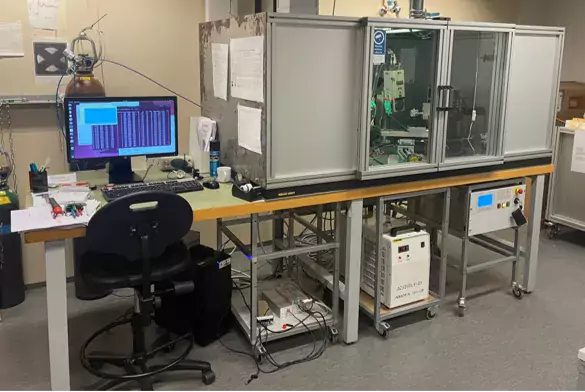HelXAS
It is located at the
The 2017 version of the setup is throuroughly described in the following article, which the users of the facility should cite:
A.-P. Honkanen et al., Johann-type laboratory-scale x-ray absorption spectrometer with versatile detection modes,
(
Since the original design, the HelXAS has gone through several smaller and larger upgrades. Most imporantly, a microfocus X-ray tube (Micro-X-ray, Inc.) has been installed to provide high resolution at low Bragg angles thanks to the small (50 micrometers) source size. A revolver monochromator unit allows for automatic and easy exchange between up to 4 monochromators that can be installed on the motorized stage. Detectors have been updated as well. The most common detector that we use currently is a Si drift diode (X-123SDD from Amptek, Inc.). Translation and rotation are performed via mechanics mostly by Huber Diffraktionstechnik GmbH & Co. The fluorescence mode detection setup has been improved considerably during the past years.
Thanks to its simple and modular design, XAS measurements can be performed in transmission, fluorescence, and imaging modes, with easy accomodation of additional equipment and complex sample environments whenever required for e.g. in situ catalysis studies.
HelXAS is designed to work ideally in the 5-20 keV energy range, allowing the study of 3d metals from Ti to Zn and 4f elements such as Ce and Nd for example, and giving the opportunity to probe the local environment of actinides such as Th and U, or heavy metals such as Mo and Zr.
HelXAS is a wavelength dispersive spectrometer, built from a Johann type Rowland circle scanning device, using spherically bent crystal analyzers (SBCA) with 0.5-m and 1.0-m bending radii and a 1.5 kW X-ray tube. The design allow XAS experiments over energies 5-20 keV, covering most 3d transition metal K-edges, lanthanide and actinide L3-edges and 5d transition metal L edges. Alternatively a Micro-X-ray water-cooled 100 W Ag anode can be used for experiments that require smaller source size.
The achieved energy resolution is typically ~1 eV at 10 keV depending on the crystal analyzer and the Bragg angle. The instrument is equipped with an helium chamber designed to limit the X-ray absorption by air along their source-analyzer-detector path, which is particularly important in the low energy range.
A fire-proof gas bottle cabinet and gas sensors are also available in the experimental room allowing in situ chemical reaction studies. A multi-sample exchanger is also available in order to automatize batch of samples measurement without user's intervention.
The
| X-ray source and power generator |
- or alternatively - |
| Detectors | - Silicon drift diode ( - Silicon drift diode ( - Photon counting imaging detector ( |
| Sample environments | - Sample exchanger wheel with 16 sample slots - An air-tight sample wheel for 8 samples |
| Auxiliary equipment | Acrylic He chamber with 25 um thick Kapton windows |




